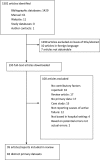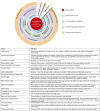Development of an evidence-based framework of factors contributing to patient safety incidents in hospital settings: a systematic review
- PMID: 22421911
- PMCID: PMC3332004
- DOI: 10.1136/bmjqs-2011-000443
Development of an evidence-based framework of factors contributing to patient safety incidents in hospital settings: a systematic review
Abstract
Objective: The aim of this systematic review was to develop a 'contributory factors framework' from a synthesis of empirical work which summarises factors contributing to patient safety incidents in hospital settings.
Design: A mixed-methods systematic review of the literature was conducted.
Data sources: Electronic databases (Medline, PsycInfo, ISI Web of knowledge, CINAHL and EMBASE), article reference lists, patient safety websites, registered study databases and author contacts.
Eligibility criteria: Studies were included that reported data from primary research in secondary care aiming to identify the contributory factors to error or threats to patient safety.
Results: 1502 potential articles were identified. 95 papers (representing 83 studies) which met the inclusion criteria were included, and 1676 contributory factors extracted. Initial coding of contributory factors by two independent reviewers resulted in 20 domains (eg, team factors, supervision and leadership). Each contributory factor was then coded by two reviewers to one of these 20 domains. The majority of studies identified active failures (errors and violations) as factors contributing to patient safety incidents. Individual factors, communication, and equipment and supplies were the other most frequently reported factors within the existing evidence base.
Conclusions: This review has culminated in an empirically based framework of the factors contributing to patient safety incidents. This framework has the potential to be applied across hospital settings to improve the identification and prevention of factors that cause harm to patients.
Conflict of interest statement
Figures
References
Publication types
MeSH terms
Grants and funding
LinkOut - more resources
Full Text Sources
Medical
Miscellaneous


